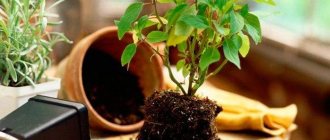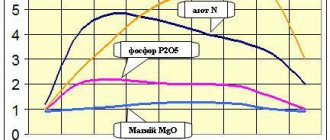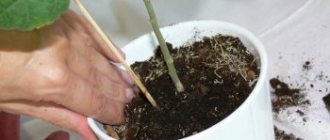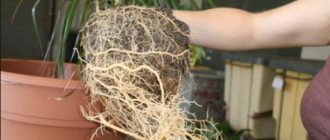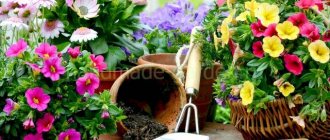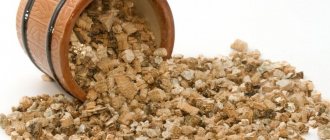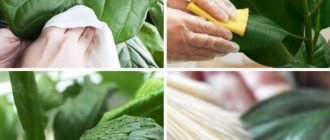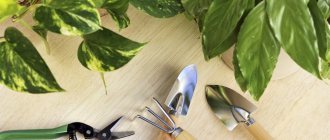Soil characteristics
In order not to make a mistake with the choice of soil, you need to know its main characteristics and correlate them with the requirements of a particular type of substrate.
The main characteristics of the soil include:
- porosity and looseness of the soil, which determine air penetration (soil aeration);
- ability to pass moisture (moisture permeability);
- ability to retain moisture (moisture capacity);
- nutrient conductivity;
- acidity level - pH. If Gloxinia, Hydrangea, Dieffenbachia require a slightly acidic environment (pH 6.0–6.5), then Rose, Cineraria, Chrysanthemum require a neutral environment (pH 6.5–7.0), and a slightly alkaline environment is suitable for Adenium and Narcissus. As a rule, the pH is indicated on the soil package.
How to make your plant healthy?
Like all types of flowering plants, bulbous plants prefer fertilizing using nitrogen, phosphorus and potassium fertilizers. After the bud fades and the leaves begin to die, it is necessary to reduce watering and leave the planting material in the container
. The plant should remain in this state until March - until it begins to produce stems again.
You need to water the flowers very carefully, as they cannot tolerate waterlogging - this can cause them to get fungus or contract infectious diseases. This is especially true for varieties such as Dutch hyacinth. Naturally, if you want to receive beautiful flowers next year, you must follow several important rules:
- Bulbs should not be stored in a damp place where they may rot;
- do not store the bulbs with fruit in the refrigerator, as some fruits emit ethylene, a substance harmful to plants;
- It is best to store bulbs in sand or peat moss;
- make sure that there is no draft that can blow through and freeze the planting material;
- If you have pets, make sure that during storage they do not chew off future flowers.
Only with proper care and maintenance will bulbous indoor flowers delight you with their brightness, beautiful buds and aroma of freshness.
Bulbous types of flowers are distinguished by decorative flowering and relative ease of care. Their home varieties are not as popular as garden varieties. However, even in a pot you can get high shoots and bright inflorescences.
Soil composition
To make the right choice, you should pay attention to the composition of the soil mixture. It determines how often watering, replanting, fertilizing and their quantity are required.
High peat
High-moor peat (a product of the decomposition of sphagnum growing in raised bogs) is part of most soils. It is widely used in its pure form for cultivation both in private, indoor culture and in agriculture. High-moor peat is characterized by high moisture capacity, breathability and lightness. It is these properties that made it a leader among other primers. An additional “bonus” for residents of regions with hard water in the water supply is the acidic environment of peat. It moderately neutralizes salts when watering, although this effect is short-lived.
Indoor plants are rarely grown on pure peat, because it is extremely poor in nutrients. In addition, unwatered peat has difficulty absorbing moisture. Those who use soils based on high-moor peat know what a headache watering such a substrate becomes. The pot with overdried soil should be placed in a basin of water and wait until the peat has collected the required amount of moisture.
Lowland peat
Lowland peat (obtained from low-lying bogs, wetlands) is rich in nutrients. That is why it is used mixed with high-moor peat as part of the most popular soils for indoor plants. In its pure form, lowland peat is not used at all: due to its fine structure, it is quite “heavy”, quickly cakes, retains water and has low air permeability. This factor can play a cruel joke, for example, with aroids, the roots of which are easily damaged due to stagnation of water.
Sod land
Similar to “vermicompost”, the glory of turf soil is popular among people. Sod is the root-inhabited part of the soil. As with humus, turf soil can be different, which means it is impossible to talk about a single quality standard for such soil. Its quality depends on the specific location: if on the territory of abandoned collective farms/state farms the turf soil is good, then in the field it is not so good. The main disadvantage of turf soil is the need to remove residues of other plants, followed by steaming to remove possible microorganisms.
For independent experiments, it is better to use soil from garden farms where fruit trees are cultivated. “Coniferous soil” is very popular - it is light, aerated, has a slightly acidic reaction and is in many ways similar to peat, although it does not dry out so much that you have to soak the pot with the plant for hours. Almost any sod-leaf soil is relatively poor in nutrients (or slowly releases them).
Light, medium and heavy earth mixtures
Why do the leaves of indoor flowers turn yellow - what to do?
The composition of the substrate is divided into several types:
- lungs;
- average;
- heavy.
The light mixture includes 40% peat, 15% garden soil, 5% leaf or turf soil, 40% sand. In addition, it is necessary to add additional components: agroperlite, vermiculite, charcoal, fine expanded clay. The light mixture is ideal for the following indoor plants:
- desert cacti;
- succulents with thickened leaves.
To root cuttings with a weak root system in a pot, light mixtures are also used, but during growth it is necessary to periodically fertilize additionally.
For the average mixture the following components are required:
- peat - 30%;
- garden soil - 25%;
- leaf or turf soil - 15%;
- humus - 5%;
- sand - 25%;
- vermiculite and charcoal as additional components.
Medium soil mixtures are considered universal. Suitable for palm trees, some types of succulents, and decorative foliage indoor plants.
Note! If in doubt about the selection of soil for your flower, it is better to loosen it a little by adding the appropriate components.
To obtain heavy soil mixtures, you need to take 35% of peat, 25% of soda soil, 20% of leaf or turf soil, 10% of sand, 10% of humus. Additional components include wood bark, pine needles, sphagnum, and charcoal. Heavy soil mixtures are prepared for the following types of house plants:
- tropical palms;
- vines;
- ferns;
- azaleas;
- begonias;
- fuchsia;
- tropical cacti.
Large plants with a well-developed root system are also planted in heavy soil.
Most of the ingredients in the mixtures can also be prepared independently.
Humus soil
Compost or humus soil is obtained from animal manure. Horses and cows usually provide good material. It is placed in a compost pit or simply on a heap, well covered with darkened oilcloth and kept in this state for 2 years. Then the resulting raw materials are sifted.
Note! If the humus is of high quality, then its structure is loose and homogeneous. There are no lumps in it, and especially the smell inherent in manure.
Sand
Sand is mainly used as a drainage material. With its help, oxygen access to the root system of the plant is ensured. This is an essential element of any type of soil mixture. For house plants, it is recommended to take river sand, but it must be well washed beforehand.
Leaf ground
For leaf soil, it is necessary to collect fallen leaves of different tree species. They are especially valued from apple, ash, and linden trees. It is not recommended to take leaves of oak, willow, poplar, and chestnut. The collected leaves are poured into compost pits, sprinkled with slaked lime.
Coniferous land
Coniferous soil can be collected from a pine or fir forest. Bottom layers are suitable. At home, coniferous soil is prepared in this way:
- collect fallen pine needles;
- in a compost pit, lay them in layers with peat and sand (layers 15-20 cm thick);
- withstand about 2 years.
Coniferous land
Tall varieties of bulbous flowers
Hippeastrum is one of the most famous representatives of this class of plants. Its bulb is round and slightly elongated, most often large (diameter about 11 cm). Up to 6 buds are formed on strong bare peduncles. The petals are folded into a funnel shape. Hippeastrum usually blooms in winter or spring. The height of an adult plant can reach 70 cm.
The color and other characteristics of flowers depend on the type of crop. She has about 85 hybrids and varieties. The most popular:
- Graceful - white-lemon or white-green shade of petals;
- Striped - red-lilac stripes on white petals;
- Reticulate - crimson-red buds with dark veins;
- Leopolda - the color of the petals is red at the end and white at the base, large buds (up to 18 cm).
Amaryllis is often confused with hippeastrum. It is distinguished by its pear-shaped bulb (also large) and the ability to bloom only once a season (in autumn). Amaryllis can form up to 12 buds. The flower has one appearance - Beautiful. The color of the petals is pink-red. This flower can live in the same pot with other amaryllis (3-4 pieces each) and is considered a long-living indoor plant.
Eucharis or Amazon lily reaches a height of 50 cm. Reminiscent of narcissus. Blooms from October to January and from March to May. The process can be extended by cutting off wilted buds in time. The flowers are pure white, fragrant, collected in an umbrella.
Attention! Eucharis can be moved to a garden plot for the summer by planting the bulbs in April to a depth of 25-30 cm.
Hybrid canna is a striking representative of domestic plants up to 1 m high. Buds are formed on each shoot and are painted in bright shades. Vallota is distinguished by a pleasant combination of white and red. The flower shape is an umbrella. This variety does not need to remove faded buds. Cut them off completely only after the flower stalks have completely dried.
Hippeastrum bulbs
Soil acidity
Soil for gloxinia - what kind of soil is suitable for a flower
The suitability of the substrate for indoor plants is characterized by such an indicator as acidity. The essence of this parameter is the following - displaying the content of hydrogen ions (pH). For neutral or alkaline soil, the pH corresponds to 7. Indicators below mean acidification of the soil, and an increase in pH means an increase in alkalinity.
Important! Purchased mixtures always indicate the acidity of the substrate. In general, indoor plants prefer neutral and slightly acidic soils. But there are also specimens that like a more acidic environment.
Flower growers should know which indoor flowers love acidic soil. The list is provided below:
- azalea;
- ferns;
- hydrangea;
- camellia;
- monstera;
- anthurium.
Measuring soil acidity
In addition, you should know which trees and bushes like acidic soil. These include viburnum, blueberry, rhododendron, raspberry, buckthorn, and Japanese quince.
Slightly acidified, almost neutral ones are preferred:
- asparagus;
- amaryllis;
- begonia;
- pelargonium;
- tradescantia and many others.
Plants that love alkaline soils:
- rose;
- chrysanthemum;
- cineraria.
Forcing daffodils
When to plant daffodils for forcing
The process of forcing daffodils is similar to the procedure of growing tulips, but it has its own characteristics. For winter forcing, varieties of taceta (multi-flowered) daffodils are most often used, but other varieties can also be grown. It is important that the bulbs are dense, strong, with a diameter of at least 4 cm and weighing 60 grams or more. Low-growing varieties of daffodils with smaller bulbs are also suitable for forcing. From the moment of removal from the soil until planting for forcing, planting material should be stored at a temperature of 17 ºC. Disinfect narcissus bulbs before planting for half an hour in a pink solution of potassium permanganate or in a solution of Fitosporin (Maxim).
Daffodil bulbs are planted for forcing on October 15. The forcing substrate is used with the following composition: 2 parts garden soil and 1 part sand. Neutral peat, sand, and even sawdust are suitable for daffodils. The size of the pot depends on how many bulbs you want to plant. The main thing is that the dishes have drainage holes. The container is filled halfway with the substrate, the bulbs are lightly pressed into it, positioning them so that they do not touch each other or the walls of the pot, after which the bulbs are covered with the substrate to two-thirds of their height. The dishes with daffodils are placed in a loosely packed plastic bag and kept for 11-15 weeks in a dark place with high humidity at a temperature of 5-9 ºC. During this entire period of time, you should inspect the daffodils twice a week, monitoring the humidity and temperature of the storage. When the sprouts formed by the daffodils stretch up to 10 cm, the container is transferred to a bright room and kept at a temperature of 17 ºC, maintaining air humidity of about 50%, and with the beginning of flowering the temperature is reduced to 11-12 ºC.
The timing of flowering can be adjusted: if you want daffodils to bloom in March or April, they need to be placed at a temperature of 3-4 ºC on December 15, and brought into a warm room two weeks before the planned flowering. Keeping opened daffodils in cool conditions will make them bloom longer. When the flowers fade, take the container to a cool place, wait until the leaves wilt, dig up the bulbs and store them at 17 ºC until planting in the ground.
Additional components in the soil composition
Auxiliary substances in the soil mixture are like lifesavers for amateurs and professionals. Some improve soil looseness, others increase moisture permeability, and others protect against excessive moisture.
Below we will touch only on the most popular ones:
Vermiculite is a natural mineral that holds water well (up to 200-300% of its own weight) and slowly releases it along with dissolved minerals. It is used as a component of soils for hydroponic growing of plants, for growing seedlings, and in its pure form for rooting cuttings of Peonies, Roses, Chrysanthemums, Aloe.
Perlite is nothing more than volcanic glass, which becomes light and porous during heat treatment. It is used by almost all greenhouse growers and therefore often frightens buyers who think that these are insect eggs or part of the mythical “transport soil”. Perlite gives the soil greater looseness and breathability. It is added to substrates and used in its pure form for growing seedlings.
Coconut fiber, coco soil or coconut shavings (or chips) are all products of processing the fruits of the coconut palm. The fiber is the long “strands” of the coconut shell. Coco soil can consist of fine shavings and so-called “chips” - parts of a larger fraction. Both are a product of processing the middle shell of a coconut.
The large fraction is more often used by terrariumists to create bedding for amphibians. The fine fraction received the general name “cocosoil” and began to enjoy enormous popularity primarily in the West. Coco soil is worthy of a separate publication, but here we will add that it is an ideal component for creating loose, moderately moisture-absorbing soil for almost any non-aquatic plant. Pure coco soil is used in hydroponics because... does not contain nutrients and allows you to create individual nutrition. Coconut fiber is used for growing orchids, ferns, bromeliads, and succulents.
River sand, which increases moisture permeability and prevents caking of the substrate, is widely used for palm trees, cacti and succulents. For bulbous plants, sand can be a kind of “cushion” that protects the bulb from excessive moisture. However, you should be wary of sand accumulation in the ground, because... when moistened, it does not allow oxygen to pass through easily.
Sphagnum moss with its high hygroscopicity is simply irreplaceable in substrates for epiphytic orchids, Azalea, Saintpaulia, Gloxinia, Anthurium, Aglaonema. In addition, he can help out if you need to leave for a few days. Wet sphagnum moss placed in a pot will gradually release moisture to the plant.
Charcoal - increases the looseness of the soil; it is also able to absorb excess moisture and slowly release it. However, its main property is antifungicidal and antiseptic. It prevents the development of fungi and the formation of rot. That is why it must be mixed not only with the soil, but also with the drainage layer. Charcoal is an essential component of soils for orchids, arrowroot, bromeliads, and aroids.
Dolomite chips or flour are a popular soil deoxidizer. It is often used in mixtures with high peat to reduce the acidity of the latter. A soil mixture with peat-based dolomite flour becomes more suitable for plants that prefer a neutral and slightly alkaline reaction: many types of palm trees, cacti and succulents. In addition, this additive enriches the soil with magnesium, which is especially necessary during the active growing season.
Please note : in inexpensive brands of soil, dolomite flour is replaced with ordinary chalk. It copes well with the main task of reducing acidity, but does not transfer nutrients into the soil.
Recently, hydrogel (otherwise known as aquasoil) has been widely used as a moisture-retaining additive in soil. It is used when growing seedlings and potted plants. This polymer ingredient ensures maximum soil breathability and reduces the need for watering by 3-6 times. In some cases, the hydrogel itself can act as a primer. In the granules that swell after contact with water, cuttings take root well and cut flowers do not wither for a long time. In addition, in tandem with liquid fertilizers, Dracaena, Cordyline, Guzmania, Chlorophytum, Lily, Fuchsia, Syngonium, Schefflera, Maranta grow happily in such aqua soil. Hydrogel, unlike conventional primer, can be used without changing for 2 years.
Planting and caring for indoor bulbous flowers
The technology for growing potted bulbous flowers is simple. The bulb is able to accumulate nutrients and moisture, so the plant can survive unfavorable periods without problems. Description of the main nuances of caring for these flowers:
- They are universal in relation to the ground. Any substrate for flowering crops is suitable for successful cultivation. Just be sure to form a drainage layer at the bottom. Above it - at least 7 cm of soil mixture mixed with special fertilizer for bulbous plants.
- Provide your flowers with plenty of light in spring and summer.
- In the warm season, the room temperature should be within +20...+25 °C. During the rest period, it is desirable to be 5-7 °C lower.
- Ideally watering a flower will be provided by slightly warm rainwater or melt water. If there is none, take the usual one from the tap and leave it to brew for 24 hours.
- The frequency of watering in spring and summer is regular, but in small portions. During the dormant period, watering is reduced to a minimum.
- Bulbous plants do not need frequent feeding. Practice applying fertilizers only during the phases of intensive growth and the beginning of flowering (about once every 2 weeks).
The main points of the method of growing different bulbous plants are almost identical. Differences can only be in the frequency of watering and fertilizing. A simple algorithm for caring for crops will help turn your windowsill into a beautiful flower garden.
Most bulbous plants need replanting. According to its periodicity, three groups of plants are distinguished. Let's figure out together which garden crops need to be replanted and when.
First group
This group includes bulbous plants that do not overwinter in the ground. They are planted in the spring and dug up in the fall. These are perennial plants, but they will simply die in the conditions of central Russia or further north if they are not dug up. Classic representatives are gladioli. More rare are acidanthers, montbretia, crocosmia, galtonia, tigridia, nerine. I’ll make a reservation right away: many gardeners overwinter in the middle zone for montbrecias, crocosmias and galtonias, but no one can give a 100% guarantee that they will survive. Whether to take risks or not is up to you. Such plants are dug up as late as possible (before persistent frosts begin) so that the bulb gains as much strength as possible before wintering. And they are planted either immediately in a permanent place when the soil thaws, or even earlier - in the house for seedlings and transferred to open ground at the first opportunity.
Second group
This group includes classic plants - tulips, hyacinths, imperial hazel grouse, which winter in the pound, but require annual digging. More exotic, but sometimes found on sale are the Persian hazel grouse, p. Radde, b. Modest, b. Severtsova (Korolkovia). This also includes a number of representatives of the onion family, for example caratavecus. All these plants are dug up annually, since their homeland is dry and hot areas and the bulbs need strong heating to form a flower bud or simply during a dry period. If the bulbs are not dug up, tulips (especially fringed and parrot tulips) may not form a beautiful flower. Hyacinths will worsen flowering, and a number of varieties will simply die. The imperial hazel grouse, depending on the variety and location, may bloom annually without digging, or maybe not.
Third group
This group includes plants that do not require annual digging: all small-bulbous plants, daffodils, botanical tulips. But their digging frequency is very different. Let's look at a classic example - daffodils. Their bulbs can grow without replanting for up to 5 years. They will not bloom in the first year if the bulb is too dry during storage. And then the daffodils will gain strength, and the peak of flowering will come; in the fourth year. Then it will weaken and a transplant will be required. This plant can withstand replanting well even in bloom, but the classic planting time is late June early September. Many will say that they planted daffodils much later. There are many such examples, but we are talking about the classic recommended planting time.
A little bit about everything
Colchicum grows in one place for 5 - 6 years. An earlier transplant is carried out if you need to separate the baby. But replanting at a later date is, in principle, possible, but then the bulbs become smaller and bloom worse. In this case, digging occurs in June, and planting in August. You missed it a little and you’ll be planting flowers.
Most crocuses have a very good division rate, and it is not worth keeping them in one place for more than three years. They will not stop blooming, but the quality of flowering will suffer. Crocuses are dug up at the end of June and planted in September - October.
Kandyki are rare guests in our gardens and each species requires its own approach. The frequently encountered hybrid 'Pagoda' reproduces well and needs to be replanted every 3 - 4 years. Varieties of K. european (dog fang) are also divided every 3 - 4 years. But our Siberian and Caucasian cats reproduce very poorly and therefore can grow in one place for 5-10 years. But they self-sow. However, these species grow for 5–8 years before flowering. Digging is carried out at the end of June, this is especially critical for the Siberian, Caucasian and European bulbs; later the bulb becomes fragile and breaks easily. It is better to plant immediately - within a week, otherwise there is a danger of drying out the bulb.
Most species of hazel grouse can not be replanted for years - they produce few children and feel great. But such widely known ones as R. chess or r. fox-berry, it’s a good idea to plant it every 2-3 years. Otherwise, flowering will weaken. Digging at the end of June, planting in September - October.
To each his own time
It is better not to keep Umbrella and P. drooping in one place for more than 3 years. Other species can sit in one place for longer. Digging at the end of June, planting in September - October.
Most decorative bows need digging about once every 3 years. They dig after the foliage dies; for some species this is July or even later. Planted in September - October.
Bulbous indoor flowers are distinguished by the fact that they have modified - usually underground - shoots with a round formation called the bottom. Roots gradually appear around the bottom, developing after planting the bulb in the ground.
For bulbous indoor flowers (amaryllis, wallflower, etc.), special pots with drainage, made of slightly baked clay, are prepared. River or rain water is suitable for irrigation.
The right soil with your own hands
If it is not possible to buy really high-quality soil or the substrate is required in large quantities, you can prepare it yourself.
To create the correct soil per 10 liters you will need:
- High-moor peat - 7 l or 5 l (more peat is necessary for plants that prefer an acidic reaction, as well as in cases where you want to fertilize plants less often);
- Coco soil (fine fraction coconut shavings) - 2 or 4 liters, respectively (the more coco soil is used, the more often the plant will have to be fertilized, since coconut shavings do not contain nutrients);
- Perlite - 0.7 l;
- Vermiculite - 0.3 l (if the cocosoil content is high, vermiculite is not required, perlite is added instead).
This instruction is not ideal, since it requires the owner to more carefully (compared to using store-bought soil) control over the amount of fertilizer and use it more frequently. We remind you that coco-soil does not contain any nutrients, and high-moor peat contains a small amount of them. With an increased content of these substrates in the soil, the use of fertilizers is required more often. The mixture can be improved if, at the stage of soaking the coco-soil (which is mandatory), diluted fertilizers are used. Their concentration depends on the plant's need for nutrients. For demanding crops (bromeliads, ferns and palms), the concentration is reduced to 1:2. For undemanding species (Azaleas, Heathers, Camellias) - up to 1:4. If the soil is chosen correctly, the root system develops actively, taking over the space of the pot.
The better soil prepared at home
Many people prefer to buy soil for indoor plants in stores. But you can create it yourself. In this case, the mixture will have the following advantages:
- the ability to follow the exact recipe, adding exactly as many substances as required by a certain type of plant;
- adaptation of seedlings to the new composition is much faster;
- allows you to save money.
Soil mixture recipe at home
Despite the advantages, there are also disadvantages. There is a high probability of infection of an indoor flower with fungi or diseases. To avoid this, it is necessary to pre-treat the soil components.
Disinfection of flower soil
Before planting a houseplant, the soil is disinfected. Otherwise, there is a risk of mold, fungal infections and bacteria. Disinfection is required when preparing components yourself. In the case of purchased components, processing is not necessary, but it will not be superfluous.
After preliminary washing in water, disinfection is carried out in the following ways:
- treated with a weak solution of manganese;
- pour boiling water over;
- kept over steam;
- heated in the oven or microwave.
The latter method is radical, since in addition to harmful organisms, it also destroys beneficial components. Use it only as a last resort. For the same reasons, herbicides and Roundup are not used for treatment.
Important! The soil in which insects or worms have infested becomes unsuitable for planting. It is extremely difficult to remove parasites; it is easier to purchase a new mixture or its components.
The soil from under other plants is also not suitable for planting new flowers. It contains tiny particles that can become a source of infection. In order not to resort to soil cultivation in the future, wood ash is added during planting, which is a natural antiseptic.
Despite the wide selection of soil mixtures sold in specialized stores, none of them can fully provide the flower with everything it needs. Therefore, it is easier to compose the substrate yourself, following the recommendations developed for a specific type of plant.
kak.pokyer.ru
Among all the existing varieties of house flowers, bulbous indoor plants occupy a special place in floriculture. They are highly decorative of the above-ground part and are very popular in the spring landscape design of parks and flower beds. Bulbous flowers are grown for cutting to create flower baskets, bouquets and spring arrangements. Many of them grow quite successfully indoors.
The most popular houseplants of the bulbous group
Amaryllis
An exquisite plant belonging to the Amaryllis family.
Homeland of growth: South Africa. It blooms with tubular flowers of red, soft pink or snow-white color. The flowers are collected in umbrella inflorescences and located on a long peduncle, the height of which is about seventy centimeters. Amaryllis blooms in autumn. The bulb is pear-shaped and half covered with soil. Caring for this plant is easy. All this exotic needs to be provided is good lighting, regular, moderate watering, low air humidity and a period of rest in winter. Amaryllis reproduces by baby bulbs. This plant blooms for the first time in the third year after planting. This plant can also be propagated using seeds. True, such plants will bloom only in the sixth or seventh year after sowing the seeds.
Vallota
Decorative flowering perennial of the Amaryllis family, which has long dark green leaves.
In the wild, this plant grows in the subtropical regions of Africa. Currently, several varieties of this flower with large flower buds have been bred. The plant has a well-developed ovoid bulb. Most of it is in the ground. Adult plants form many baby bulbs. With good care and development of the bulbs, this plant can bloom twice a year. Flower buds form on a long, leafless peduncle. The flowers are symmetrical, collected in umbrella-shaped inflorescences. At the very base of the inflorescences, two bract scales are formed. The funnel- or bell-shaped perianth grows up to ten centimeters in diameter. Depending on the variety of wallflower, the color of the perianth can be snow-white, pink or red. The flowering time of wallflower is five to seven days.
This is an easy-to-care plant that can grow in both light and partial shade. Wallot needs protection from direct sunlight, moderate air humidity, frequent and moderate watering, as well as regular fertilizing.
This flower is propagated using bulbs during replanting in the spring.
Hyacinth
This is perhaps the most common plant in houses and apartments, belonging to the group of bulbous plants.
Decorative perennial of the Liliaceae family, native to the Mediterranean and Asia Minor. This is a bulbous plant with narrow leaves and a long leafless peduncle, the length of which is thirty centimeters. Hyacinth blooms with very beautiful waxy bell-shaped flowers. The length of one flower varies from three to five centimeters. Depending on the variety, the color of the flowers can be snow-white, light pink, blue, yellow, hot pink and purple.
Hyacinth is revered by many gardeners due to the exquisite aroma of flowers and a long flowering period. One peduncle grows from each bulb. Flower shops sell bulbs intended for forcing. If you plant them in September, you can have hyacinths in bloom by Christmas.
Caring for bulbous hyacinths is almost the same as caring for other indoor plants. This flower requires good lighting, regular soil moisture, fertilizer and the same temperature regime.
These indoor flowers can be propagated at home in several ways - by baby bulbs, mother bulbs and bulb scales.
Hippeastrum
A plant native to the tropics and subtropics of South America.
Unlike other flowers in this group, hybrid forms of hippeastrum are distinguished by their highly decorative aerial parts and a long flowering period. A cut bouquet of hippeastrum flowers retains its beauty for ten to twelve days. There are over seventy varieties of this exotic. All of them are decorative flowering hybrids. These are plants with large bulbs from which long, strap-like leaves grow. Peduncles are bare, up to seventy centimeters long. Depending on the species, the flowers of this plant come in a wide variety of colors: white, red, pink. Several flower stalks with two or three flower buds can form simultaneously on one bulb.
The plant's bulbs are poisonous, so you should follow all safety rules when working with them.
Caring for hippeastrum is the same as caring for other bulbous house flowers. It includes systemic watering, regular fertilizing, bright lighting and stable temperature conditions. In winter, during the dormant period, the hippeastrum is placed in a cool place, fertilizing is stopped and watering is reduced. This flower can be propagated by bulbs or seeds.
Zephyranthes
Decorative flowering perennial with narrow long leaves.
The length of one sheet is forty centimeters. This houseplant is native to the tropical areas of Cuba. Currently, there are two varieties of marshmallows that are grown at home - white and large-flowered. Both species have a round, not very large bulb that is located underground. The appearance of leaves occurs along with the formation of flower buds. Zephyranthes is valued for the decorativeness of its flowers and the duration of flowering - from the beginning of spring to almost the end of summer. The flowers are large, funnel-shaped, located on long leafless peduncles. The bloom of one flower lasts only two days, after which new flower buds appear.
Caring for bulbous zephyranthes is quite simple. These are light-loving flowers, so first of all they need good lighting. In addition, zephyranthes needs frequent but moderate watering and low air humidity. This bulbous plant reproduces with the help of baby bulbs or seeds.
Clivia
Bulbous indoor plant with gorgeous leaves and flowers.
In its natural environment, this flower grows on the West Coast of South Africa, where there is high humidity. Clivia is an easy-to-care evergreen plant that has very beautiful leathery dark green elongated leaves. The flowers are large, collected in inflorescences. Up to thirty flower buds can form in one flower arrow.
There are many varieties of indoor clivias. They all differ in shape, color of leaves and flowers. Flowers come in a wide variety of shades - from light yellow to dark red. Clivia is a shade-tolerant bulbous plant that does not require high humidity and bright light. To achieve lush and colorful flowering, this flower needs to be provided with a proper dormant period: temperature within ten degrees and moderate watering after each drying of the soil.
Clivia can be propagated using side shoots, each of which should have several leaves. They are separated during the process of flower transplantation, after which they are immediately planted in the ground.
Nerine
A herbaceous bulbous plant with decorative strap-shaped leaves and numerous flowers.
This flower is native to the mountainous regions of South Africa. Unusually shaped flowers of various shades - pink, snow-white, red, consist of petals bent back and wavy at the edges. Large decorative flowers, collected in umbellate inflorescences, are located on a long leafless flower arrow. The leaves appear after the flower buds open. The length of the leaf plate reaches thirty centimeters, the width is three centimeters. Basic care for nerine indoors consists of moderate watering, timely replanting, and good lighting. Unlike other flowers in this group, the resting period of nerine begins in the summer, and this is its peculiarity. The flowering period of nerine occurs in autumn - mid-October, the growth of bulbs and leaves occurs in winter. Nerine reproduces using baby bulbs or seeds obtained from pollinated flowers.
What soil for plants is better to buy
When choosing which soil to buy for plants, most gardeners give preference to specialized mixtures for planting a specific type of plant. At the same time, many summer residents purchase a universal version, but at the same time try to improve its quality with the help of additional additives. Recently, mixtures based on coconut fibers and hydrogels have also become very popular - compositions intended for planting moisture-loving crops.
As for the soil mixtures from this rating, the following conclusions can be drawn:
- The best universal option for planting most types of flowers is ASB Greenworld.
- The Seliger-Agro soil mixture contains a good complex of mineral elements necessary for the high-quality growth of small crops.
- For planting all types of ficus, citrus and primroses, you can use flower Fusco.
- Herbaceous aquatic life thrives best in JBL Manado's nutritious soil.
- For planting almost all types of aquarium flora, ready-made Tetra Active Substrate is suitable.
- Peter Peat Hobby peat mixture is enriched with a full range of microelements necessary for the quality growth of thuja.
- Agricola for pine needles is particularly loose and has the ability to retain moisture well.
- Sera Floredepot mixture is perfect for growing fastidious flora.
- “Good Assistant” has the widest range of applications, from planting seedlings and fruit and berry bushes to preparing lawns.
The main rule when choosing the best soil for plants is to carefully study the composition and characteristics of the soil mixture: perhaps it already contains a complex of microelements necessary for their normal development.
Rating of the best soils for plants
To compile this rating, we took into account the opinions of experienced agronomists, who advise when choosing soil for plants to pay attention to the following qualities:
- Softness, lightness and friability;
- Acidity;
- Compound;
- The presence of a certain set of micronutrients;
- No foreign matter or debris;
- Good aeration (ability to pass air);
- Required humidity;
- Convenient packaging;
- Price.
Also, when selecting goods, we paid attention to the volume offered by manufacturers. Today, several types of mixtures can be purchased in stores. Flower growers divide the soil mixture into universal (intended for planting most unpretentious crops) and special, which takes into account the specific needs of plants. Our rating includes the most popular options of both the first and second types.
The best soils for flowers
When growing flowers, it is very important to choose good soil for indoor plants, because the speed of their growth and development depends on its composition. Our rating includes the 3 most reliable options, according to florists.
Seliger-Agro for flowers and indoor plants
This peat-based crumbly soil is intended for replanting indoor flowers and ornamental plants. It has a rich brown color and contains a fairly large complex of useful microelements (nitrogen, phosphorus oxide and potassium). The soil is packaged in 5 liter plastic bags and has an unlimited shelf life, which is very practical when it is necessary to replant a small number of flora representatives. For ease of use, the manufacturer has included detailed instructions on the packaging.
Advantages:
- Quite loose;
- No lumps or debris;
- Compact packaging;
- Easy to care for flora;
- Affordable price.
Flaws:
- Doesn't absorb water very well.
The Seliger-Agro mixture has a fairly high rating on websites, but experienced users advise taking into account that after watering the soil settles - it will probably have to be replenished over time.
ASB Greenworld for flowers universal
ASB Greenworld soil has a universal purpose and can be used for growing ornamental plants and seedlings, as well as lawns, or for filling holes when replanting ornamental trees. It is recommended for camellias, kalanchoes, begonias, violets, gerberas, roses, phlox, peonies, and daylilies. The only exceptions are flowers that prefer acidic soil. This composition accumulates and distributes nutrients well, does not caking and has high air exchange qualities.
Advantages:
- Easy;
- Crumbly;
- Convenient packaging that does not tear;
- Wide range of applications (both at home and in the country);
- Contains a good range of micronutrients.
Flaws:
- Sometimes you come across quite large wood chips.
Many gardeners value this soil for its versatility, but most buyers advise sifting it thoroughly before use to get rid of large pieces of wood.
Fusco floral
This flower soil is recommended for planting violets, geraniums, ivy, roses, chlorophytum, monstera, yucca, dracaena, tulips, crocuses, daffodils, iris, all types of ficus and citrus fruits. It is completely ready for use and contains a well-balanced set of nutrients necessary for the full development of plants. The soil does not contain pathogenic elements and viable weed seeds; the raw material promotes the development of the root system of flowers.
Advantages:
- Clean;
- Soft;
- Creates good conditions for development;
- Free from trash and weeds;
- Absorbs moisture well;
- Inexpensive.
Flaws:
- Prone to hardening.
The main rule for using Fasco is to first open the package, mix its contents and let the soil saturate with oxygen for an hour.
Diseases of bulbous plants - possible problems
| Symptoms | Causes | Remedy |
| The plant does not produce leaves or does not bloom | The bulb died as a result of a fungal disease. The affected bulbs become soft to the touch and light. Spring bulbs usually rot after thawing. | Discard the onion and wash the pot thoroughly. Plant bulbous plants in a clean substrate without impurities. |
| The plant has put out leaves, but does not bloom | improper storage, especially at high temperatures, leads to the death of the flowering parts of the bulbs, although the tissues responsible for leaf growth are preserved. Small, weak bulbs may not have enough cells to flower. The presence of rich foliage and sparse flowers may be the result of the use of nitrogen fertilizer | try to buy fresh onions that have not been left on the shelves. Choose large specimens. |
| Leaves appear at the edges of the pot | the bulb or tuber was planted with the top down. | the tops of the bulb or tuber usually have a pointed shape. If you can't tell where the top of the bulb is, it's best to plant it sideways in the ground. |
| Leaves grow slowly, buds fall off without opening | dry air, sudden change in conditions. | increase watering and humidity. Do not move plants during bud stage. |
| The leaves are succulent and grow well, but unopened buds are dropped | too abrupt a transition from cold to warm conditions | Having taken spring-flowering bulbs out of a cold place, send them for 1 week to a cool, but not warm, room. The transition from cold to warm conditions should be gradual. |
| Plants grow large and unstable | too warm conditions at an early stage of growth or lack of light. | place the bulbs close to each other - this will help slow down their growth; place in a cooler room. Do not place in a warm place until the buds begin to open. Light-loving plants are drawn to bright light. |
| Unhealthy leaves, with small yellowish spots | spider mite | Remove affected plants as the mite may spread to other plants |
Universal soil for house flowers
The basis of the universal soil for indoor plants is peat, which contains amino acids and humic acids that promote normal growth and development of flowers.
For compilation we use:
- highland and lowland peat;
- sand;
- nutrients.
The advantage of the peat mixture over street chernozem is that it is looser, therefore, it allows water and oxygen to pass through well. Over time, peat soil does not lose its properties. Most common store-bought plants were grown in this type of soil. Transplanting into universal soil, similar in composition to store-bought soil, will relieve the flowers from unnecessary stress.
Peculiarity! Peat has antiseptic properties.
The disadvantage of peat soil is the need to constantly keep it moist. When the substance dries out, it stops absorbing water. For plants that require special maintenance conditions, universal soil is not suitable. The situation can be corrected by independently adding the necessary components to it.
Hyacinth
Many gardeners grow this plant to decorate their summer cottage. However, it also feels great in a flower pot. Hyacinth consists of narrowed linear leaves growing just above the root system. During flowering, it shoots out an elongated arrow, on which flowers subsequently appear, collected in a spike-shaped inflorescence. In this regard, it has a strong resemblance to a lilac branch. Depending on the type, hyacinth petals can change color from white to bright blue and be smooth or terry.
Specialized soils
Divided into groups for:
Cacti, succulents
The main features of the finished mixture are high water permeability and a low amount of nutrients. It is achieved through the following composition: sand (usually river) - approximately half, and the second half - leaf soil or high-moor peat.
For cacti, it is permissible to add a little coarse sand to the finished mixture. But if the cactus is forest, then it is better, on the contrary, to use a product based on high-moor peat.
Palm
All plants of this type are suitable for breathable, loose soil. Therefore, you should give preference to products based on high-moor peat with the addition of sand, leaf and turf soil. As the plant grows, you must remember not only to feed and replant the palm tree in time, but also to increase the amount of turf soil in the pot.
Saintpaulia, other Gesneriaceae
Only acidic soil is suitable for this family of plants. Optimal soil can be obtained by mixing high-moor peat, sand or perlite (for looseness), coniferous soil, coal and sphagnum (for moisture capacity).
Orchids
There is no single type of soil for orchids, as these flowers are divided into several groups according to their habitat. For example, epiphytic orchids live on trees and bark, sometimes mixed with moss and coal, is best suited for them, but they wither in peat.
For the ground type, a mixture of peat, coal, bark and moss, on the contrary, is ideal.
Bromeliads
The mixture usually consists of top peat, sand and leaf soil. For looseness, bark, coniferous soil, sphagnum, and coal are often present.
Ferns
They always grow in moist, loose soil that is also rich in organic matter. If the store does not have a ready-made mixture for your plant, you can take a mixture that is poor in organic matter for cacti (from peat, sand), add humus or leaf humus to it in a 1:1 ratio.
Gardenia
The main characteristics of the substrate are light, acidic, nutritious. The mixture usually consists of high-moor peat, river sand and humus or leaf soil replacing it, as well as coniferous soil.
Azaleas
The finished product for these flowers should be light, air-permeable, moisture-permeable, and also acidic. You can achieve such properties by taking high-moor peat and coniferous soil (1:1).
General features of bulbous flowers
These plants grow from underground shoots that have a characteristic short, flat thickening at the bottom, and form a bulb. The scales of the bulbs are filmy or fleshy, do not have chlorophyll, and therefore are colored creamy. Potted bulbous flowers are usually grown from perennial bulbs. The older the shoots, the more magnificent, beautiful the color and richer the aroma of the plant.
The natural environment of bulbous crops is a hot, dry climate. In its natural habitat, the plant must have time to develop, form flowers and produce seeds in a favorable period of time - the rainy season. When grown at home, each flower has its own algorithm. But it consists of the same stages looped together:
- A period of intense growth. The pot dweller develops quickly, blooms many buds and fades.
- Rest period. At this time, the flower needs minimal care and no stress.
Attention! Bulbous flowers bloom consistently every season, often even twice a year.
Criteria for choosing soil for indoor plants
The selection of soil for a home flower depends on its variety. There are universal mixtures on sale that are suitable for most indoor plants, but their composition does not fully meet all the needs of individual plants.
Among the general selection criteria, the following stand out:
- absence of parasites and pests;
- loose structure allowing air to reach the roots;
- optimal acidity level;
- content of essential nutrients suitable for a specific plant type.
Important! When purchasing finished products, pay attention to the expiration date. When stored longer than expected, serious changes occur in the composition of the soil.
It is impossible to determine the quality of the substrate before opening the package. Therefore, when purchasing, it is better to choose familiar and trusted brands. If you are buying soil for the first time, the composition indicated on the package will help you decide on your choice. There should be no signs of mold or rot inside the bag. If any are found after opening the package, the soil cannot be used.
Main mistakes when choosing
- Purchasing the wrong type of soil mixture. For example, buying a heavy substrate for a plant that grows in light soil - pine, edelweiss.
- Error with the pH of the mixture. Corrected by acidification or deoxidation of the soil.
- Insufficient aeration. Corrected by adding baking powder.
- Insufficient or excessive moisture capacity. Corrected with appropriate impurities. For example, in case of insufficient moisture capacity, add moss or coal.
Sources
- https://LePlants.ru/tsvetovodstvo/sekrety-vybora-pravilnogo-grunta/
- https://pocvetam.ru/komnatnye-rasteniya/zemla-dla-cvetov.html
- https://ufermer.com/komnatnye-rasteniya/vybor-grunta.html
- https://vyborexperta.ru/sad_i_ogorod/luchshiy-grunt-dlya-rasteniy/
- https://yanashla.com/luchshij-grunt-dlya-rastenij/
[collapse]
Combination possibilities in potted ensembles
When selecting plant combinations, the main goal should be to extend the flowering time. Tulips and daffodils are the stars of potted gardens. But they are just beginning to break through and form leaves, when snowdrops , crocuses , muscari , spring flowers and other primroses are already actively blooming. For mixed compositions, try to plant plants in tiers, focusing specifically on the flowering time. Moreover, they are arranged in tiers both literally and figuratively. Tulip bulbs need to be planted much deeper than crocus or snowdrop bulbs. Thus, in the pot, the plants are located at different depths and bloom at different times: while the primroses are blooming with might and main, the tulips are just beginning to hatch.
Until February, until the first signs of the beginning of the growth of primroses appear, the pots will actually stand empty. You can plant intercrops in them that can decorate the garden in autumn and even winter. In this case, it is better to choose plants whose root system will not damage the bulbous plants themselves and will not deplete the soil too much. Winter Erica , pansies or ornamental cabbage are quite suitable for the role of temporary inhabitants of containers with bulbous plants.
You can combine bulbous and perennial plants. They can easily be planted with potted and potted woody, herbaceous perennials such as santolina , thyme , heuchera , lavender , rhizome , bergenia , boxwood , cereals (especially calamus, which today is increasingly being introduced into the design of potted gardens), ivy and other winter-green stars. And their seemingly sudden appearance next to more “permanent” plants will always surprise no less than in a full-fledged flower garden.
Planting several types of bulbs in one container. © Natasha Starkell
